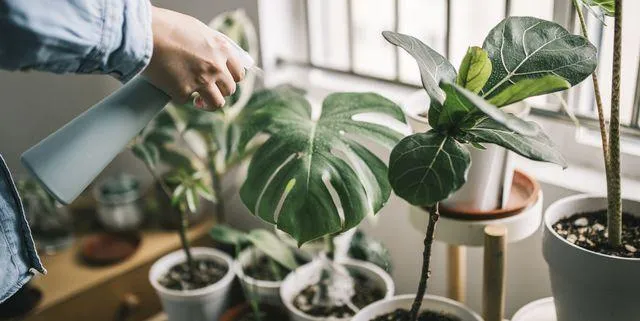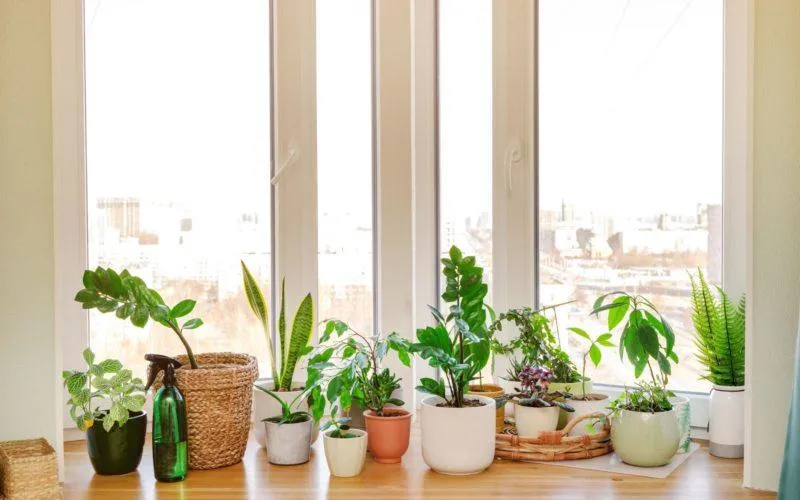No Sunlight? No Problem! 10 Indoor Plants That Thrive Without Direct Sunlight
If you find yourself stuck inside without access to natural sunlight, don’t despair – there are plenty of beautiful houseplants that can survive and even flourish in low-light conditions. Indoor spaces without windows or with limited daylight present a challenge for plant parents, but fear not – the following varieties are tough as nails and will add green to your home without strong sun exposure.
1. Snake Plant (Sansevieria trifasciata)
Top of the list for low-light tolerance is the classic snake plant. From my experience, snake plants are legendary for their resilience – they can survive weeks without water and thrive in very dim indoor spaces. Their tall, upright leaves with bold vertical stripes make for an eye-catching decorative element. These plants release oxygen and remove toxins from the air even in the lowest of light conditions. Propagation is also easy via division of existing plants. Simply split the roots and replant the offset – voila, a new snake plant!
2. Chinese Evergreen (Aglaonema)
With their colorful leaves in shades of green, cream, and pink, Chinese evergreens are a favorite indoor plant species for low-light areas. I’ve found they prefer brighter filtered light if possible, but can tolerate quite low light levels if given consistent moisture. These plants are non-toxic to pets and humans alike. Additionally, they are great air purifiers, removing benzene and formaldehyde from indoor air. Preventing root rot is key – allow the soil to dry slightly between waterings.

3. Pothos (Epipremnum aureum)
Famous for being nearly impossible to kill, golden pothos or devil’s ivy is a top choice for beginners. From my experience, these trailing vines can thrive in very dim conditions near a north-facing window or other low-light spot. They are remarkably forgiving of inconsistent watering too. Not only do pothos add visual appeal hanging from shelves or trained up a moss pole, but their heart-shaped leaves also boast the ability to remove common indoor air pollutants like benzene, formaldehyde, and trichloroethylene. Minimal care yet maximum benefits – doesn’t get better than that!
4. Peace Lily (Spathiphyllum)
With their glossy dark green leaves and dramatic white blooms, peace lilies brighten up any home. These beauties actually perform best out of direct sunlight. In my experience, a spot with muted light like a few feet back from an east-facing window suits them perfectly. Peace lilies efficiently filter out mold spores, bacteria, and other allergens from indoor air in relatively low-light conditions. They also bloom most when conditions are not too harsh – a quality that makes them suited for lower-stress environments without glaring sun exposure. Regular watering to keep the soil moist is their key need.
5. ZZ Plant (Zamioculcas zamiifolia)
Nicknamed the “zz plant,” Zamioculcas zamiifolia is renowned for being able to thrive even in very dim rooms. I’ve seen zz plants survive for months with no attention whatsoever! Their waxy leaves appear to almost glow even without strong light. In shaded spots, these plants will still grow, albeit at a slower rate than in brighter light. ZZs remove formaldehyde from indoor air while requiring only occasional watering. They also propagate effortlessly by dividing the tubers. Low fuss and extremely resilient, the zz plant is a prime choice for low-maintenance, shadowy corners.

6. Cast Iron Plant (Aspidistra elatior)
True to their name, cast iron plants are outstanding for surviving low-light conditions almost indefinitely. They do not need much care or attention at all once established. I’ve seen lovely specimens sitting under furniture or near windows with thick curtains for years. thanks to their durable nature. In shaded spots, their strappy green leaves will still appear lush and full. Cast iron plants purify indoor air of benzene, trichloroethylene, and formaldehyde in dimmer locations too. Practically impossible to kill yet adding vibrancy – aspidsitras are an ideal option.
7. Spider Plant (Chlorophytum comosum)
With their grassy green leaves shooting up from rosettes and miniature plantlets nestled along the leaf margins that can be removed and propagated, spider plants are a fun and effective choice for brightening up low-light nooks. Spider plants thrive on neglect and can survive for lengthy periods with inconsistent watering, growing new plantlets all the while. They gracefully remove benzene, trichloroethylene, and formaldehyde from indoor air even without strong light exposure. Spider plants flourish in shaded corners and under tables year-round with minimal maintenance needed.
8. Chinese Money Plant (Pilea peperomioides)
Trendy Chinese money plants attract attention with their cute coin-shaped leaves. Though they grow more slowly without ample light, from my experience they do quite well in moderately lit indoor spots, tolerating lower light levels than some other favorites. These plants remove common volatile organic compounds like benzene, acetone, ammonia, and trichloroethylene from the air. Water only when the soil becomes dry – these plants are prone to root rot issues if overwatered. Their adorable foliage makes them a joy to look at even amid dimmer conditions.

9. Janet Craig Dracaena (Dracaena deremensis ‘Janet Craig’)
With their slender upright canes topped with dark green sword-shaped leaves streaked in creamy white, Janet Craig dracaenas lend elegance to any space. As a bonus, they are very tolerant of lower light. Dracaenas thrive on neglect and can go many weeks without watering. I’ve even seen specimens survive in nearly lightless bathrooms! They effectively eliminate indoor air pollutants like benzene, formaldehyde, and xylene even in duller areas. Janet Craigs grow slowly but remain attractive for years in locations getting minimal sunlight exposure. Low maintenance yet gorgeous additions that require only occasional watering.
10. English Ivy (Hedera helix)
Last but not least, the classic English ivy thrives in very low-light conditions and enhances any home through its ability to climb walls and trail along shelves. In poorly lit corners, ivy may grow more slowly but retains its dark green, glossy leaves beautifully. It tolerates low light much better than some other trailing plants. Ivies remove pollutants like benzene, formaldehyde, trichloroethylene, xylene, toluene and ammonia from indoor air. They are nearly impossible to kill and propagate effortlessly when stems are placed in soil. With their natural climbing habit, ivies add visual appeal in low-ceilinged areas with insufficient sunlight.
In summary, while plants generally grow best with ample, bright light, the above 10 varieties have proven their resilience in very low-light indoor environments through extensive use in offices, bathrooms, basements and other windowless areas. With a bit of trial and error to find the perfect spot, you can easily bring the calming, air-purifying benefits of houseplants into low-sunlight spaces too. Focus on moisture-loving pothos, peace lilies, spider plants and Chinese evergreens for best results in dimmer conditions. With diligent care, they’ll thrive for years and brighten up your home even without strong sun exposure.

Indoor Plants That Thrive Without Direct Sunlight
| Plant | Light Needs | Water Needs | Growth Rate | Care Tips |
|---|---|---|---|---|
| ZZ Plant | Low Light | Allow Soil to Dry Between Waterings | Slow | Tolerates Neglect, Water When Top inch is Dry |
| Philodendron | Low Light | Water When Top inch is Dry | Moderate | Thrives in Warm Humid Spaces, Tolerates Low Light |
| Pothos | Low Light | Let Soil Dry Out Between Waterings | Moderate | Tolerates Neglect, Thrives in Various Light Conditions |
| Chinese Evergreen | Low Light | Water When Top inch is Dry | Slow | Tolerates Low Humidity, Keep Soil Consistently Moist |
| Snake Plant | Very Low Light | Water Infrequently, Allow Soil to Dry Completely | Slow | Thrives With Neglect, Remove Dead Leaves as Needed |
FAQ
- What kinds of plants can grow without direct sunlight?
Many common houseplants tolerate low-light conditions quite nicely. Some good options are pothos, snake plant, Chinese evergreen, peace lily, philodendron, and ZZ plant. These plants basically only need indirect sunlight from a window. - Do indoor plants without sunlight need less water?
Sort of. Plants thriving in low-light spots often need less water than those in brighter areas. Without direct sun, they won’t dry out as quickly. Nevertheless, soil moisture should still be checked regularly since lack of water can weaken any plant. - Why do some plants do better without lots of light?
It appears certain plant species evolved to flourish with only weak or dappled light found on forest floors in nature. Their leaves tend to be thicker and waxy to retain moisture longer without direct sun. At the same times, they’ve developed less demand for photosynthesis which relies on sunlight as an energy source. - Is it possible for a plant to get “too much” shade?
Yes, arguably. Providing inadequate light is basically the same as depriving a plant of a vital nutrient. Most require at least some indirect sunlight each day to be sustained. Ironically, too much shade could end up being more of a challenge than too much sun! But is that fair? Maybe a happy medium is key. - How long can an indoor plant survive without light?
Most authorities agree low-light houseplants can endure weeks with merely artificial room lighting. However, their health will gradually fade withoutrenewal. Extended periods of total darkness may set off irreversible decay. Perhaps supplementing natural shade conditionswith occasional brief periods under grow lights could keep plants hanging on longer. - What are some ways to boost light indoors for plants?
Place plants near the brightest windows is the classic approach. But moving them around weekly gives more light exposure. Or try a simple clamp-on desk lamp aimed at foliage. Grow lights installed on a timer also work wonders for trickier spots, as cited by botanical experts. Amusingly, allegedly one crazy plant parent reportedly set up a disco ball reflector arrangement for their greenery! - Do plants need direct sunlight to photosynthesize and grow?
While direct sun is optimal for most species to fully carry out photosynthesis, many can still get by with quite low levels of diffuse daylight. The process relies on visible light rather than strictly direct rays. Still, boosting ambient indoor light where possible seems advantageous. What’s your experience – have you noticed growth differences with varied light conditions? I’d be curious to hear other readers’ insights on this question too. - What is the minimum light requirement to keep an indoor plant alive?
Plant biologist Ruth Rivard was quoted saying approximate minimum light needs for survival would amount to luminosity comparable to fairly shaded outdoor forest areas. Supposedly this is around 100-200 lux of indirect ambient light for at least 6 hours daily. Do you think there may be exceptions to even this modest threshold? I’d be interested in learning if any indoor plants could subsist on less light than what this expert indicates. Readers, what say you on the matter?
